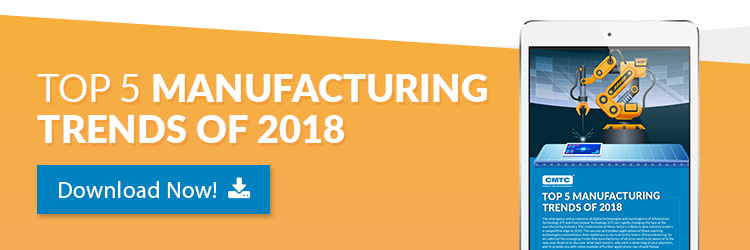August 24, 2018 | Human Resources, Robotics & Automation
5 Ways Manufacturers Can Successfully Onboard New Hires
 Losing workers from the factory floor is never easy, especially for small and medium-sized manufacturers (SMMs) where the output of every employee can be critical to maintaining production quotas and keeping customers happy. When an employee leaves, it’s then critical that SMMs are able to attract skilled workers and onboard them quickly and adequately to minimize production disruptions and ensure a smooth integration that will lead to higher employee retention (after all, the less often you have to do this, the better!).
Losing workers from the factory floor is never easy, especially for small and medium-sized manufacturers (SMMs) where the output of every employee can be critical to maintaining production quotas and keeping customers happy. When an employee leaves, it’s then critical that SMMs are able to attract skilled workers and onboard them quickly and adequately to minimize production disruptions and ensure a smooth integration that will lead to higher employee retention (after all, the less often you have to do this, the better!).
A new study reveals that manufacturers have a very short window with which to create a positive experience for new hires. After just one week at a new organization, 33% of new hires know whether they want to stay long-term; this figure jumps to 63% after the first month. So, manufacturers setting up employees with an effective onboarding experience from day one increases the likelihood that their new hires will turn into skilled lifers. Here are five ways SMMs can help ensure exactly that.
1. Contact new hires before their start date
If there is a lengthy gap between the day an applicant accepts an offer and their start date, don’t leave them hanging. A simple phone call from HR in the interim, or an email from their new manager describing their first day, will put any nerves at ease and let them know they’re valued. Many tech-savvy manufacturers have taken to setting up onboarding portals that new employees can access prior to their start date to fill out necessary forms so their first day isn’t awash in paperwork. In addition to tax forms and other paperwork, some SMMs are using these portals to provide training documents in advance to help the new hire onboard quickly. These documents should not be made required reading (after all, you’re not paying them yet) and they don’t need to be tomes either. But for go-getters, the document helps them understand their new role with your company. A few things to include:
- A “day in the life” from the standpoint of a new employee with limited experience. Document what they’ll be doing and how they’ll do it.
- Structured information in an easy-to-read format. Forget the big words. Write it at a fifth-grade reading level even if the position requires a college degree.
- Easily digestible information, i.e. include bullets, numbers—even illustrations.
First days are all about first impressions; not just the teams’ first impression of the new hire, but his or her first impression of the company. Have a new hire email message sent to all employees prior to the new hires’ arrival so everyone knows who this stranger is; be sure badges are issued and any equipment is set up; if training on equipment is necessary, be sure someone is available; provide a welcome packet of information and company knick-knacks; and consider a team welcome lunch at no cost to the newbie (inviting a few key members rather than the whole team may be better, and less intimidating).
3. Keep new hire schedules tightly structured
Without a tightly structured schedule, new hires may be left bored, unsure of what to do—or worse yet, thinking you don’t know what to do with them. Consider developing a shared calendar that managers and HR can use to create task lists and schedules for new hires, so they always know where they need to be, what they’ll be doing, and who they may be interacting with. As the new hire begins to understand his or her role and begins taking the lead without direction, their schedule can become less structured (as it suits the company’s policies).
4. Get the Whole Company Involved
While appointing a buddy or mentor can be valuable at first, scheduling some one-on-one time between new hires and existing workers in other relevant areas during their first few weeks, including job shadowing, will give the new hire a better understanding of their role and where they fit in. While some SMMs may balk at taking away other employees from their day-to-day jobs in order to onboard new hires, ultimately the value this brings offsets the temporary loss of productivity. Also, be sure not to overlook scheduling some time between new hires and veterans on the cusp of retirement; they may be able to drop some vital tribal knowledge on new hires which can be key for the continued success of your facility. Without strong onboarding programs that provide one-on-ones with soon-to-be retirees, new hires may never gain the valuable knowledge they need to succeed and help grow your business.
5. Set expectations and encourage feedback
New hires—especially those of the younger, more diverse generations—want to know what is expected of them, where they fit in, and where there is opportunity for growth. Rather than keep them dissatisfied and in the dark, set defined yet realistic short- and long-term goals for new hires and communicate with them early on so they can begin to envision a lasting future with your company. Have managers check in regularly to see if new hires are meeting goals and to provide constructive criticism and kudos. You also want to encourage feedback from the employee; don’t be afraid to ask new hires what they like and don’t like about their job thus far—perhaps through an anonymous survey. Plus, you never know where the next great idea may come from; often, they can come from the fresh perspective of a new set of eyes.
While all the above are designed to get new hires to “hit the ground running”—and they will certainly help—it doesn’t mean new hires should be saddled with a ton of work or responsibility right out of the gate either. According to Inc.com, it may take up to eight months for a new hire to reach full potential, especially depending upon their position. But that shouldn’t dissuade SMMs from streamlining the process. While the rate of digital transformation varies across manufacturers, it’s imperative for survival that onboarding become productive from the get-go. Millennials and the next wave of employees, Generation Z—the first true digital natives—expect a technologically sophisticated process that caters to them. Following the recommendations highlighted above, manufacturers can make the process smoother and encourage retention, but it’s still no substitute for time and patience. As they say, slow and steady wins the race!

